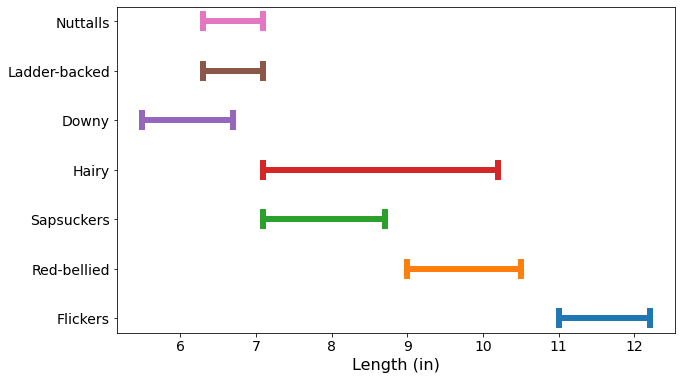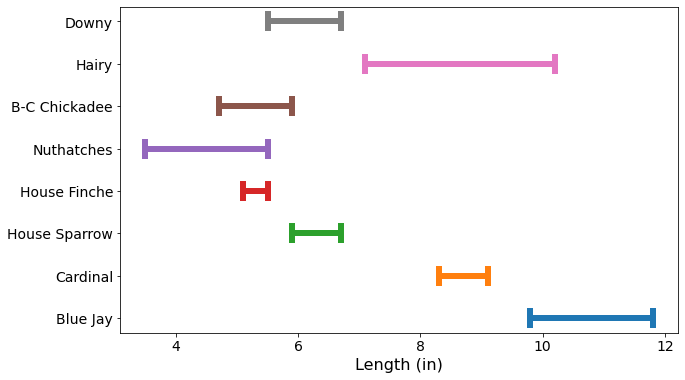Downy or Hairy: Which Did I See?
Dryobates are difficult. There are five North American species in this genus that all look very similar. Downy and Hairy are two of the most common and also perhaps the most easily confused.
Birders have found a number of useful indicators for distinguishing these species and continue to debate which are helpful or not. Below, I've done my best to summarize field marks and discuss their limitations. These comments are partly based on other sources (see references) and partly based on my own experience identifying thousands of Dryobates woodpeckers on iNat.
1) Body Size
In my opinion, overall size is the most reliable way to distinguish Downies and Hairies. The average Hairy is roughly 50% longer than the average Downy. However, as you can see below, the full size ranges of the two species come very close, with large Downies similar in size to small Hairies. Another catch is that size can be difficult to judge from photos and sometimes even in the field. I've added a plot at the end of the journal showing Downy and Hairy sizes compared to a few common feeder visitors.
Length ranges of woodpecker species:

- Length information from All About Birds, except RBWO which came from Animal Diversity Web/U Michigan.
Check out the references for side-by-side comparisons. Here are a few good iNat observations with both species:
https://www.inaturalist.org/observations/37269809
https://www.inaturalist.org/observations/102042425
https://www.inaturalist.org/observations/135449778
And one with a few different woodpeckers:
https://www.inaturalist.org/observations/144996080
2) Beak Size
After body size, beak size is my second most reliable indicator. The stereotypical Downy has a short, thin beak that is less than half the length of the head, and the stereotypical Hairy a long, thick beak that is about the same length as the head. Easy enough, right? The reality, of course, is that beak sizes vary with overlapping ranges. I've noticed some regional variations in beak size. For example, Hairies in the northeastern part of their range often have smaller beaks, whereas Downies in the southeastern part of their range tend to have thicker beaks. Knowing the regional Downy/Hairy characteristics can help with the trickier identifications.
Here are typical examples of each species from my observations:
| Hairy Woodpecker | Downy Woodpecker |
|---|---|
 |
 |
This Downy from my observations has a beak that seems thicker than typical.

Here are a few examples of varying beak sizes from other observations:
Downy - https://www.inaturalist.org/observations/98353524, https://www.inaturalist.org/observations/101967828, https://www.inaturalist.org/observations/102136353, https://www.inaturalist.org/observations/102215091
example of missing feathers making beak appear large: https://www.inaturalist.org/observations/123634300
Hairy - https://www.inaturalist.org/observations/101843876, https://www.inaturalist.org/observations/101980097, https://www.inaturalist.org/observations/102115637, https://www.inaturalist.org/observations/102211227
3) Markings
Of the distinguishing characteristics, I've found markings to be the least reliable overall due to the amount of individual and regional variation. There are a few markings (1-3 of the list below) that are reasonably reliable when used with an understanding of their limitations.
A general guideline that I've found helpful with markings is that the presence of a marking is usually more indicative than its absence. Part of the reason for this is that photo quality and the bird's posture, among other factors, can affect what markings are visible.
I will also mention here that Downy/Hairy are most easily distinguished from other Dryobates species by the large white patch on their back. If the back isn't visible, you can look for subtle differences in the facial patterns, and both ladder-backed and Nuttall's are typically more spotted on their sides and bellies.
These are markings that I've seen mentioned for distinguishing Downies and Hairies:
- Tail barring
Most Downies have black barring on the outermost tail feathers. The thickness and darkness of the barring is variable, and Downies with no barring are observed on rare occasions. Tail barring is most reliably noted from views of the underside of the tail. When the tail feathers are folded in, the outermost feathers are on the bottom and not always visible. When viewed from the back, birds with heavy barring might have black spots visible on the edges of the tail (second Downy photo above), but often the barring is not visible (first Downy photo above). Photo quality also affects whether the spotting/barring is visible from the back. Also note that Hairies occasionally have tail barring, particularly in the Pacific Northwest and Newfoundland.
Here's a Downy with weak tail barring: https://www.inaturalist.org/observations/101426711
And a Downy that seems to be missing a few of the barred feathers: https://www.inaturalist.org/observations/126428786
And a rare one without barring: https://www.inaturalist.org/observations/44652584
And a Hairy with a few spots: https://www.inaturalist.org/observations/101727100
- Split red patch
The red patch of male Hairies is often split down the middle by a black line. This varies among individual birds with some having a clearly split patch and others having only a thin split or none visible at all. Lower quality photos may obscure the split, especially if it's thin. Occasionally, Downies may also appear to have a split red patch from missing or displaced feathers or individual variation.
Examples of typical splits: https://www.inaturalist.org/observations/102122763, https://www.inaturalist.org/observations/102026084
I have also seen claims that female Hairies have a black split in the white headband but Downies don't. In my experience, this is a very unreliable mark. It may be more common for Hairies to have a split headband, but I've seen plenty of Downies with them too.
- Shoulder comma/spur
Hairies often have a black stripe (aka comma, spur) running down the front of their shoulders. Long and significant shoulder spurs are a good indicator for Hairy. However, not all Hairies have them, and Downies occasionally have a short black spur, so use caution with this mark. Given that many photos are taken from behind, the shoulder spur is often hard to see.
Here's an example of a shoulder spur from my observations:

And a Hairy with only a small spur: https://www.inaturalist.org/observations/101727100
And an example of a Downy with an apparent small spur: https://www.inaturalist.org/observations/102256826
- White neck patches
The rule of thumb here is that Downies have large white patches on the neck and Hairies have narrower ones. While this generally seems to be true, there also seems to be quite a bit of individual variation. Look closely at the first two photos in this journal - the size of the white patches doesn't seem significantly different for those individuals. The posture and position of the bird can also affect how big or small the white patches look. This marking may be useful in combination with other characteristics, but it probably shouldn't be used on its own.
This is a good example of typical large neck patches: https://www.inaturalist.org/observations/101976384
Along with this marking is the thickness of the black line down the back of the neck. Larger white patches generally mean a thinner black line. However, the same holds here that there's individual variation.
- Variation in width of the black facial stripe
I've heard other birders mention that Downies have black facial stripes that noticeably get narrower in the back, whereas Hairies have stripes that are roughly uniform in thickness. This does seem to have some truth to it, but as with other markings, there seems to be a fair amount of individual variation. The first two photos above have individuals that fit this description for their respective species. The black facial markings seem to be linked with the other facial and neck markings mentioned above. In other words, more white on the neck usually means less black on the neck and face.
4) Other Factors
Another trait that can sometimes help is the fluffy feathering at the base of Downies' beaks. This is another indicator that seems to often be true but has individual variation. The photos above are good examples of the typical beak feathering expected for each species.
Here's a Downy with limited beak feathering: https://www.inaturalist.org/observations/82098581
And a Hairy with a fluffier beak base: https://www.inaturalist.org/observations/101980097
Body shape is sometimes mentioned as a way to distinguish species. I think of Downies as being more compact and Hairies longer. I've seen others describe Hairies as looking fatter. That said, shape can vary quite a bit, and fluffed out feathers, posture, and other factors can affect the apparent shape of a bird.
I've focused this journal on visual indicators, but other clues, such as call and habitat, can also be useful and should be considered when that information is available.
Hopefully you've found this journal helpful for distinguishing the Dryobates species. They're a tough bunch, so don't get too discouraged. Many of the observations on iNat may simply not be good enough for a confident species level ID. Give it your best shot, and good luck with identifying!
Also, if you see any errors in this journal or know of anything that should be added to the list, please leave a comment or message me. I'll add better examples if I find any.
Happy birding!
References
All About Birds (Cornell U Ornithology Lab)
Animal Diversity Web (U Michigan)
https://www.audubon.org/news/how-tell-hairy-woodpecker-downy-woodpecker
https://feederwatch.org/learn/tricky-bird-ids/downy-woodpecker-and-hairy-woodpecker/
https://www.thespruce.com/downy-or-hairy-woodpecker-387335
Extras!
Here's a plot comparing body length ranges of Downies, Hairies, and common feeder species.

- Length information from All About Birds.






